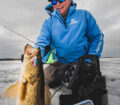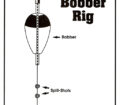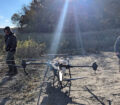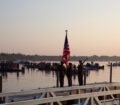By Bob Jensen
Fishing the Midwest Fishing Team
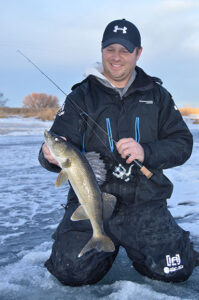
(photo by Bob Jensen) An angler appreciates quality bibs when kneeling in slush is required to land a nice walleye.
It may not look like it now, but the ice fishing season is just around the corner. In some areas, it’s already gone around the corner and is pulling into the driveway. Winter means different things to different people. To some it means shoveling the sidewalk and icy roads. But for those of us who enjoy fishing through the ice, winter brings excitement.
If you’re one of those people, following are some ideas that you might want to consider. If you haven’t discovered ice fishing but would like to, these ideas will help you get started. Here we go.
First things first: Make sure the ice is safe to walk on. Some anglers don’t think about going on the ice until there are vehicles on it. Others want to be the first one out there. I’m always content to follow. There are life jackets made for ice fishing. Clam’s Rise Float Parka will help keep you afloat if you should find a thin spot in the ice.
Matt Johnson spends more time on the ice than almost anyone. He’s fished in a lot of places early in the year for a variety of fish, but he really likes to get after panfish. Crappies and bluegills mostly.
Matt says that mobility is a priority early in the year. He likes to wear Ice Armor Bibs with a Blackfish Gale top. The bibs are durable and don’t absorb water, while the Gale allows him to be very mobile. He can drill holes and set the hook comfortably with this set-up.
John Crane is another guy who ice anglers could be envious of. He’s on the ice from as soon as it’s safe until the time when it’s no longer safe. He gets to the area that he wants to fish and drills some holes. He uses a K-Drill because it’s electric.
Electric drills are quieter than the gas drills that many of us grew up with. He uses the 6-inch hole size. A 6-inch hole can be created with less noise than a larger hole simply because there is less ice being drilled. That sounds like a small consideration, but it’s an important one.
Matt and J.C. don’t spend much time at a hole unless they see fish on their sonar. Both use Vexilars to determine if there is a potential biter below. If they see a fish, they fish. If they don’t, it’s on to the next hole.
Plastic bait on small jigs are a traditional favorite for panfish, but a bait called a Pinhead Pro is quickly becoming a very important part of many ice anglers arsenal. These baits are made of zinc alloy. Zinc alloy can be machined, so the detail on these baits is incredibly lifelike, and sometimes, especially when the panfish are skittish, lifelike is very important.
However, on early ice the fish sometimes aren’t skittish at all. Remember, these fish haven’t seen fishing pressure for several weeks. There can be a considerable time lag between the end of the open water fishing season and the start of ice fishing. If you keep quiet and show the fish a bait, chances are good that fish will bite. Start ice fishing in the areas where you last caught them in open water.
Now, first things last: Make sure the ice is safe! You don’t need to be the first one out there. But as soon as the ice is safe, drill some holes, move about quietly and fish where the fish are. If you’ve done this before, you know why you’re doing it again. And if this is the first time you’ve done this, you’ll be anxious to do it again.


